Sometimes called heavy ropes, sometimes conditioning ropes, sometimes called battle ropes, whatever the name these are a great tool for the strength and conditioning of athletes. These are large ropes, 1.5 to 2 inch in diameter and 30-50 feet long, which makes them heavier than normal ropes. To perform exercises with heavy ropes, the center of the rope is secured to something that won’t move (I like to thread it through two 45-pound plates), then both ends of the rope are stretched out. The athletes grips each handle and performs the exercises.
Heavy rope exercises can involve the entire body. There are upper body emphasis exercises with heavy ropes. However, most of these exercises involve the lower body moving, the core stabilizing, and the upper body also moving. That makes these total body exercises.
These exercises can be done nonstop for a period of time. For example, perform slams for sixty seconds. That makes them ideal for metabolic conditioning sessions.
Due to the above, they do a great job of getting an athlete’s heart rate up. Combine that with the fact that they can be rhythmical in nature and all of the above makes them a potential aerobic exercise.
There is a tremendous amount of variety possible with these exercises. Heavy rope sessions are not as boring as (for example) jogging on the treadmill for 20 minutes.
Finally, the upper body emphasis makes these a great tool for baseball and basketball players.
The challenge with these exercises is that they are difficult to implement in a team setting. It’s not unusual for facilities to have one rope per cage, even so that’s still not a lot of them. They generally cost in the neighborhood of $40-$100 depending upon the size, which can be a problem for programs with a tight budget. They also require a lot of room to perform the exercise. A 40 foot rope is going to need around 20 feet of space to stretch it out and this doesn’t count room for the athlete to exercise.
In a team setting, these exercises can be done while athletes are in rotation. They could also be combined with other exercises in a conditioning session. For example:
Athlete A: Battle ropes
Athlete B: Jump rope
Athlete C: Kettlebell swing
Athlete D: Lunges
Etc. Rotate every 30-60 seconds



